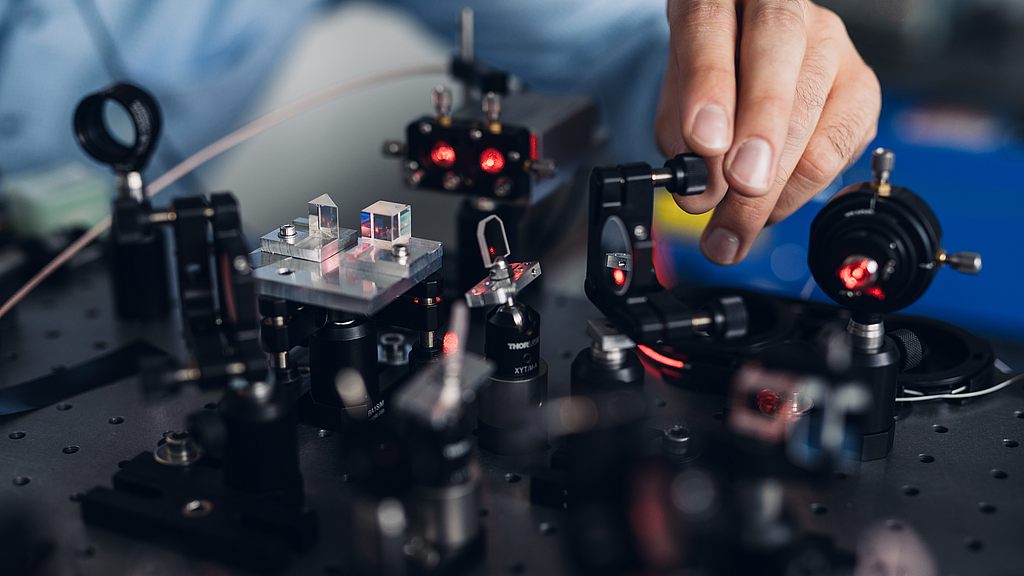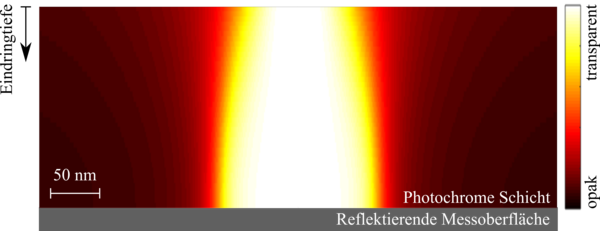Micro- and Nanoscopy Systems
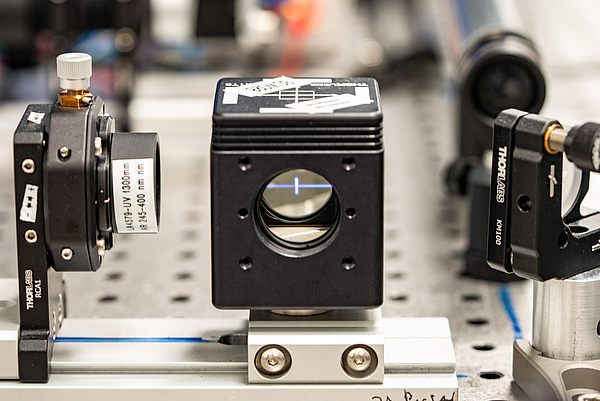
State of the Art/Motivation
- In far-field optical nanoscopy, on- and off-switching of molecular fluorescence overcomes Abbe’s diffraction limit. Though the underlying concept of using optically driven molecular transitions is not limited to switch between fluorescent and non-fluorescent states, the hitherto realized superresolution-imaging modalities almost exclusively rely on fluorescence contrast. Overcoming the diffraction limit in more general imaging contrasts (without relying on fluorescence) is usually enabled by near-field optical microscopy, which employs probes such as subwavelength apertures or sharp tips at close proximity to the sample surface in order to generate highly localized light fields or collect near-field information.
- Dynamic subwavelength apertures in direct contact with the sample surface have been realized via optically saturable transitions in photochromic compounds for resolution enhancement in optical data storage and optical lithography.
- Hyperspectral imaging with broadband measuring light enables not only an increase in image contrast, but also the detection of information about the chemical composition, tissue structure and physical properties of the measured object.
- Our field of research focuses on realization of hyperspectral, superresolution-imaging using absorption modulation for reflection microscopy.
Methods
- Simulation with a model of an AMI nanoscopy in reflection mode. We employed the nonlinear photo kinetics, the diffraction at the sub-wavelength aperture, Fresnel reflections and the imaging properties of a confocal microscope.
- Derivation of analytical estimative equations for a simplified system design.
- Simulation of hyperspectral imaging with broadband measuring light to optimize the measurement system.
- Experiments to investigate the influence of the measuring light wavelengths on the imaging process.
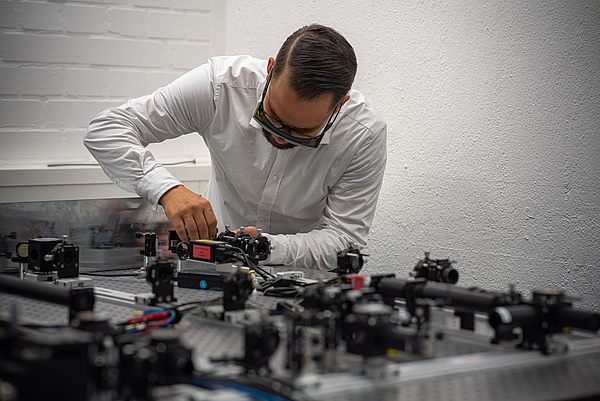
Results and current status
- With our analytical equation, the resolution-enhancement capability can be evaluated in a first predesign step (in analogy to STED). The decisive parameter is the power ratio between the beams of different wavelength. We show in our publications that this estimation fit well with our simulation results.
- Our extensive simulations show the potential to achieve superresolution of λ/5 compared to diffraction limit.
- In the DFG pre-project (412988268), the feasibility of reflected light microscopy using absorption modulation with a lateral resolution below the diffraction limit is demonstrated. The measurements were carried out with a monochromatic light source.
- DFG project (412988268) to realize reflection nanoscopy using absorption modulation with hyperspectral imaging in collaboration with the Institute for Nanophotonics Göttingen e.V., the Institute for Organic Chemistry, the Institute for Physical Chemistry and the Max Planck Institute.
- R. Kowarsch, C. Geisler, A. Egner und C. Rembe, “Superresolution reflection microscopy via absorbance modulation: a theoretical study,” in Optics Express 26 (5), S. 5327–5341. DOI: 10.1364/OE.26.005327.
- R. Kowarsch und C. Rembe, “Modellierung der Auflösungssteigerung mittels photochromer Schichten für die nanoskopische Laser-Doppler-Vibrometrie,” in Proceedings of the XXX. Messtechnisches Symposium des AHMT, Hanover, Germany, Sept. 2016.
- P. Jain, C. Geisler, D. Leitz, V. Udachin, S. Nagorny, T. Weingartz, J. Adams, A. Schmidt, C. Rembe, und A. Egner, “ Super-resolution Reflection Microscopy via Absorbance Modulation,” in ACS Nanoscience Au 2023 3 (5), 375-380. DOI: 10.1021/acsnanoscienceau.3c00013.
State of the Art/Motivation
- Conventional frequency shifters (e.g. Bragg cells) are inefficient for generation of carrier frequencies in the GHz regime and allow usually no variation of the shift frequency.
- Search of an efficient methode for the generation of a heterodyne carrier which allows a variation to use spectral regions with low noise and disturbances
- Vibration analysis of micro- or nanoelectromechanical systems vibrating at frequencies of several GHz
Methods
- Variable carrier frequency generation from MHz to several GHz with two diode lasers in the visible spectrum via frequency-offset-lock in an optical phase-lock loop (OPLL)
- Setup of a scanning, confocal Laser-Doppler-vibrometer microscope for vibration analysis of tiny structures with high lateral resolution for the reconstruction of operating deflection shapes at high frequencies.
- Modeling of generated mutual coherence (coherence collape) and the resulting vibration amplitude resolution for the laser-Dopplerinterferometry.
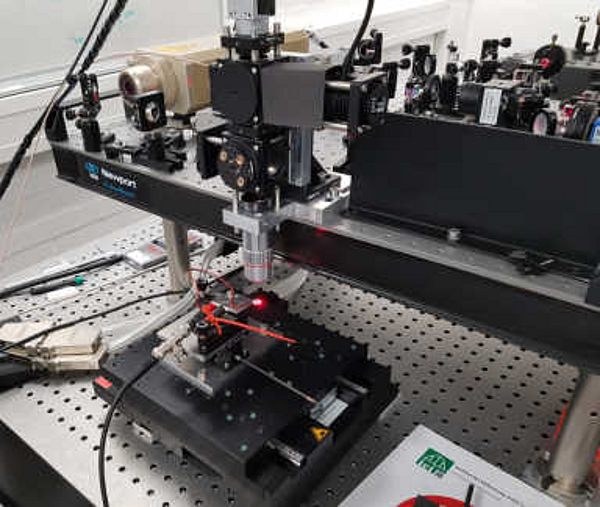
Results
- Capability of generation of a variable carrier frequency up to 1.4 GHz for the contactless vibration analysis.
- Noise-equivalent vibration amplitudes below 1 pm (at 1 Hz bandwidth) for vibration frequencies > 50 MHz despite the strong intensity noise of the semiconductor lasers.
- R. Kowarsch and C. Rembe "Heterodyne interferometry at ultra-high frequencies with frequency-offset-locked semiconductor lasers" (to be published) Measurement Science and Technology
- R. Kowarsch and C. Rembe "Laser-Doppler vibrometry with variable GHz heterodyne carrier via frequency-o ffset lock" Proceedings SPIE 10749, Interferometry XIX, 107490A (18 August 2018), San Diego
- R. Kowarsch, T. Rigele, and C. Rembe "Laser-Doppler vibrometer microscope with variable heterodyne carrier" Proceedings of 13th AIVELA Conference, Ancona, Journal of Physics: Conference Series, Volume 1149, conference 1, 2018
Scanning vibrometer microscope for vibration analysis of microsystems
- Setup of a scanning confocal vibrometer microscope for out-of-plane vibration analysis of MEMS with a self-developed software up to vibration frequency of 25 MHz.
- Choice of several excitation signals for efficient vibration analysis.
- Implementation of a vector network analyzer for electrical characterization in parallel to vibration mesurement and monitoring purposes.
Cooperations
- Vibration mesausrement on Energy Harvesters from the Choo Labs of Caltech.
- Quartz microbalances (QCM) of the Institute for Physical Cemistry of Clausthal University of Technology.
Publications
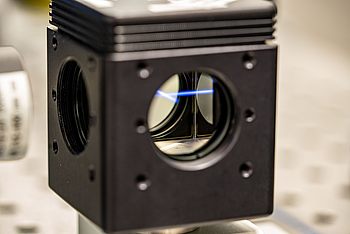
Scientific Assistant
Tel.: +49 5323 72-4967
E-Mail: leitz@iei.tu-clausthal.de
Scientific Assistant
Tel.: +49 5323 72-4967
E-Mail: jingrun.zhang@tu-clausthal.de
